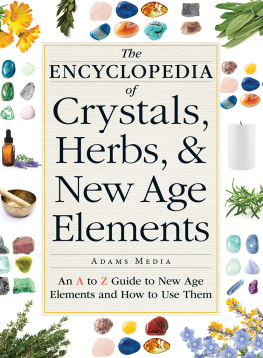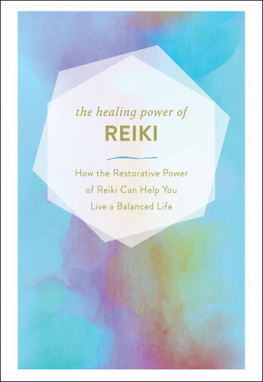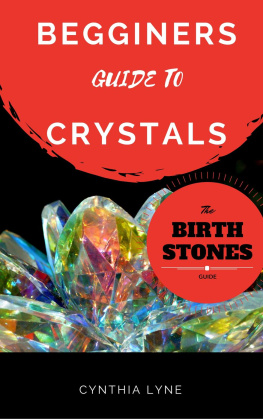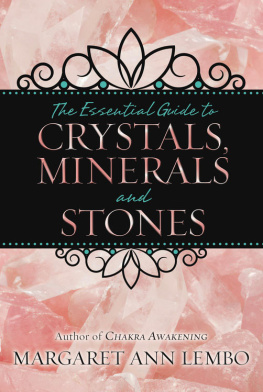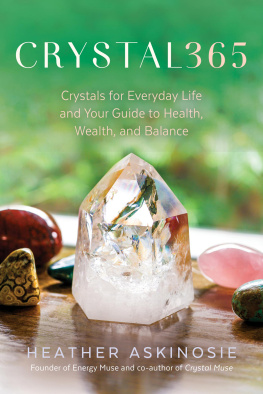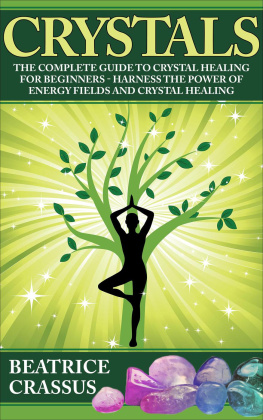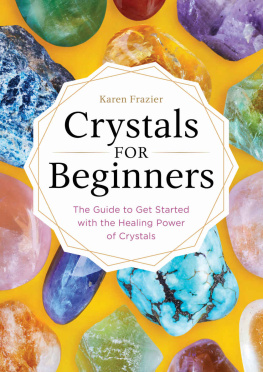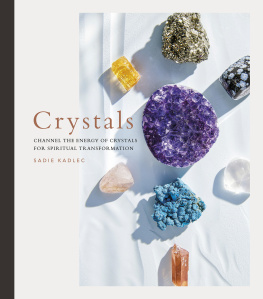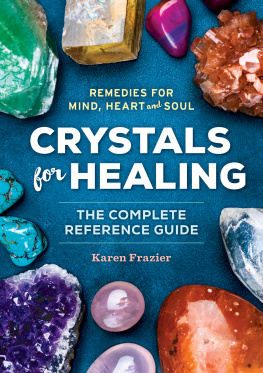Contents
Guide
The
ENCYCLOPEDIA
of
Crystals,
Herbs, &
New Age
Elements
ADAMS MEDIA
An A to Z Guide to New Age Elements and How to Use Them

Avon, Massachusetts
Contents
Introduction
New Age is a broad term that is used to describe an Eastern-influenced cultural movement that arose in the Western world in the 1970s. The New Age movement has many subcategories, including medicine, spirituality, and environmentalism, and it continues to thrive around the world today in countless constantly evolving forms.
If youve ever browsed around a New Age gift shop or bookstore, youve probably encountered a seemingly disconnected array of stones and crystals, herbs and spices, candles and incense, and books on topics ranging from astrology to yoga. Though these items all belong to disparate cultural traditions from different parts of the world at various points throughout human history, they are all part of the big New Age picture.
For thousands of years, stones, herbs, and other natural elements have been used in cultures across the globe to promote health and prosperity, provide protection, ease pain and suffering, and facilitate spiritual enlightenment. While modern advances in science and medicine have brought us invaluable medications, treatments, and therapies, many of the worlds oldest remedies and practices are still widely used and considered highly effective.
Long before hospitals and pharmacies, there were plants. The first humans were hunter-gatherers who relied on the environment for survival. They learned which plants were toxic and which were beneficial, and they developed remedies for illness and discomfort that were honed and adapted over time. The same process occurred with other natural elements, from stones to scents. In ancient Egypt, stones and crystals collected from the earth were worn to draw sickness from the body. In ancient China, herbs and roots were used to treat ailments ranging from headaches to indigestion. Remains of incense dating back thousands of years have been found all over the world. All of these practices have persisted through history and continue to be used regularly in our modern lives.
In this book, New Age novices and aficionados alike will find some of the most treasured New Age elements and practices, organized into ten chapters: stones, herbs, flowers, scent, fire and light, sound, insight, symbols, movement, and touch. Each entry covers information on the origins and various uses of the item or practice being discussed, including physical, spiritual, and magical applications.
Many of the remedies and practices in this book belong to the tradition of holistic healing, a diverse field of alternative medicine that treats the whole person, not just a single ailment or condition. Practitioners of holistic medicine believe that a person is made up of parts and if one part isnt working properly, it has a negative effect on the whole. Holistic healthcare practices covered in these pages include herbal medicine, acupuncture, and massage.
Some of the items discussed in this book have feng shui uses. Feng shui is the ancient Chinese practice of arranging the objects in your environment in a way that facilitates a free flow of energy. The bagua, which means eight-sided figure or octagon, is your feng shui map.
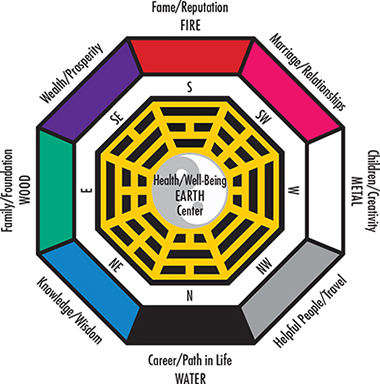
You may also see references to chakras throughout the book. In Hindu, yogic, and other traditions, the chakras are the energy centers in the body, arranged vertically along the spine. Each chakra governs a different kind of energy and connects to a different area of the physical body. The seven major chakras, from the top down, are:
- Crown chakra: Located at the top of the head, the crown chakra controls mental energy and is our connection to the divine.
- Third-eye chakra: This chakra, located between the eyes, is the seat of intuition. It governs our imagination, wisdom, and decision-making.
- Throat chakra: The throat chakra rules communication and expression, and is the source of personal truth.
- Heart chakra: This chakra is found in the middle of the chest and is all about love, joy, and inner peace.
- Solar plexus or navel chakra: This is the power chakra, the core self, located in the center of the abdomen.
- Sacral or base chakra: This is the pleasure center of the body, located in the lower abdomen, below the navel. It is the source of confidence and self-worth, and it also rules sexuality.
- Root chakra: Located at the base of the spine, this chakra is the foundation of the body and governs spiritual and physical grounding.
Some of the items found in these pages will be very familiaryou may already have them in your spice cabinet, garden, or backyardbut youll learn new ways to use and enjoy them. Others may be totally new to you, and you may soon find yourself with a new hobby! Feel free to cherry-pick through the book and look up the items that most interest you. Curious about the healing powers of crystals? Check out has the answer.) Be sure to check the glossary for any unfamiliar terms you find along the way.
Let this handy book be your go-to reference for all things New Age. As you read, remember that many of the items and practices in this book are very personal and the way they are experienced depends on the individual. What works for someone else will not necessarily work for you. Listen to your heart, body, and mind as you try out these New Age staples. Above all, enjoy the journey!
THE POWER OF STONES:
Crystals and Gemstones
Stones have been used for millennia to treat physical ailments and balance the energies of the body, as well as to facilitate mental, emotional, and spiritual well-being. They work through resonance and vibration, and through the minerals and other substances they contain. For example, the high concentration of copper in malachite can help reduce the swelling and inflammation that cause joint and muscle pain, and an analgesic called succinic acid is released when amber is warmed by the skin, making it helpful for treating arthritis and toothaches.
Stones can be found in two forms: raw and tumbled or polished. Raw stones are in their natural state, which means they may be sharp-edged or craggy and can be fragile. Tumbled or polished stones have been tumbled with fine sand or grit to smooth their edges. As a result of this process, tumbled stones are much more durable than raw stones and can be kept together (in a soft bag, for example), whereas raw stones should be kept separate to prevent scratching and breakage.
There are two main approaches to choosing a crystal or gemstone: You may be looking to treat a specific ailment or issue, or you may be simply searching for a stone that resonates with you. If you are completely new to the world of stones, your birthstone might be a great place to start. Otherwise, you can choose a stone by visiting a local store and browsing through its offerings. If a stone catches your eye, pick it up, hold it in your hand, and see how it feels. Trust your intuition. A stone that attracts your attention and feels right is the stone for you.

